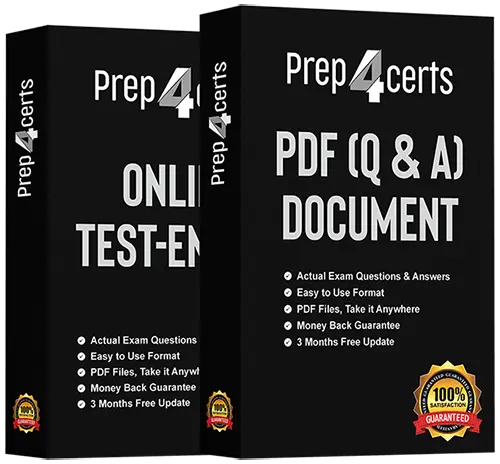
| Exam Code | 1z0-809 |
| Exam Name | Java SE 8 Programmer II |
| Questions | 196 Questions Answers With Explanation |
| Update Date | November 08,2024 |
| Price |
Was : |
Are you ready to take your career to the next level with Java SE 8 Programmer II? At Prep4Certs, we're dedicated to helping you achieve your goals by providing high-quality 1z0-809 Dumps and resources for a wide range of certification exams.
At Prep4Certs, we're committed to your success in the Oracle 1z0-809 exam. Our comprehensive study materials and resources are designed to equip you with the knowledge and skills needed to ace the exam with confidence:
Start Your Certification Journey Today
Whether you're looking to advance your career, expand your skill set, or pursue new opportunities, Prep4Certs is here to support you on your certification journey. Explore our comprehensive study materials, take your exam preparation to the next level, and unlock new possibilities for professional growth and success.
Ready to achieve your certification goals? Begin your journey with Prep4Certs today!
Which two reasons should you use interfaces instead of abstract classes? (Choose two.)
A. You expect that classes that implement your interfaces have many common methods or fields, or require access modifiers other than public.
B. You expect that unrelated classes would implement your interfaces.
C. You want to share code among several closely related classes.
D. You want to declare non-static on non-final fields.
E. You want to take advantage of multiple inheritance of type.
Given the code fragment:public class Foo {public static void main (String [ ] args) {Map unsortMap = new HashMap< > ( );unsortMap.put (10, ''z'');unsortMap.put (5, ''b'');unsortMap.put (1, ''d'');unsortMap.put (7, ''e'');unsortMap.put (50, ''j'');Map treeMap = new TreeMap (newComparator ( ) {@Override public int compare (Integer o1, Integer o2) {return o2.compareTo(o1); } } );treeMap.putAll (unsortMap);for (Map.Entry entry : treeMap.entrySet () ) {System.out.print (entry.getValue () + '' '');}}}What is the result?
A. A compilation error occurs.
B. d b e z j
C. j z e b d
D. z b d e j
Given the code fragment:List values = Arrays.asList (1, 2, 3);values.stream ().map(n -> n*2)//line n1.peek(System.out::print)//line n2.count();What is the result?
A. 246
B. The code produces no output.
C. A compilation error occurs at line n1.
D. A compilation error occurs at line n2.
Given:IntStream stream = IntStream.of (1,2,3);IntFunction inFu= x -> y -> x*y;//line n1IntStream newStream = stream.map(inFu.apply(10));//line n2newStream.forEach(System.out::print);Which modification enables the code fragment to compile?
A. Replace line n1 with:IntFunction<UnaryOperator> inFu = x -> y -> x*y;
B. Replace line n1 with:IntFunction<IntUnaryOperator> inFu = x -> y -> x*y;
C. Replace line n1 with:BiFunction<IntUnaryOperator> inFu = x -> y -> x*y;
D. Replace line n2 with:IntStream newStream = stream.map(inFu.applyAsInt (10));
Given the definition of the Vehicle class:Class Vehhicle {int distance;//line n1Vehicle (int x) {this distance = x;}public void increSpeed(int time) {//line n2int timeTravel = time;//line n3class Car {int value = 0;public void speed () {value = distance /timeTravel;System.out.println (''Velocity with new speed''+value+''kmph'');}}new Car().speed();}}and this code fragment:Vehicle v = new Vehicle (100);v.increSpeed(60);What is the result?
A. Velocity with new speed
B. A compilation error occurs at line n1.
C. A compilation error occurs at line n2.
D. A compilation error occurs at line n3.